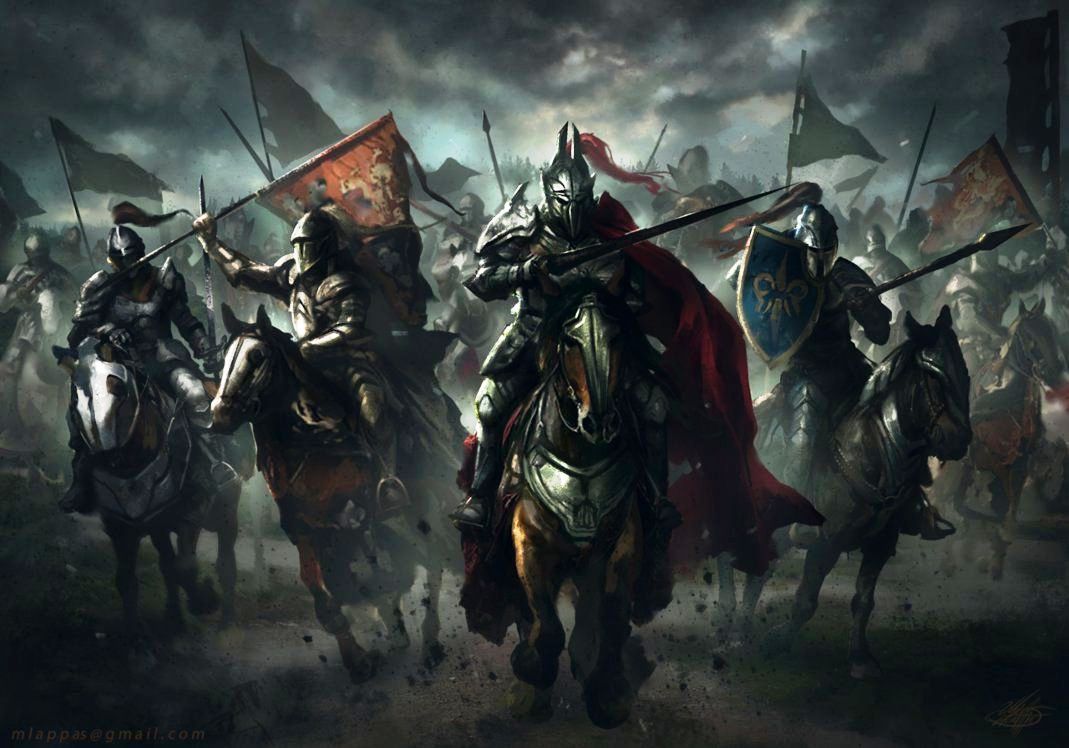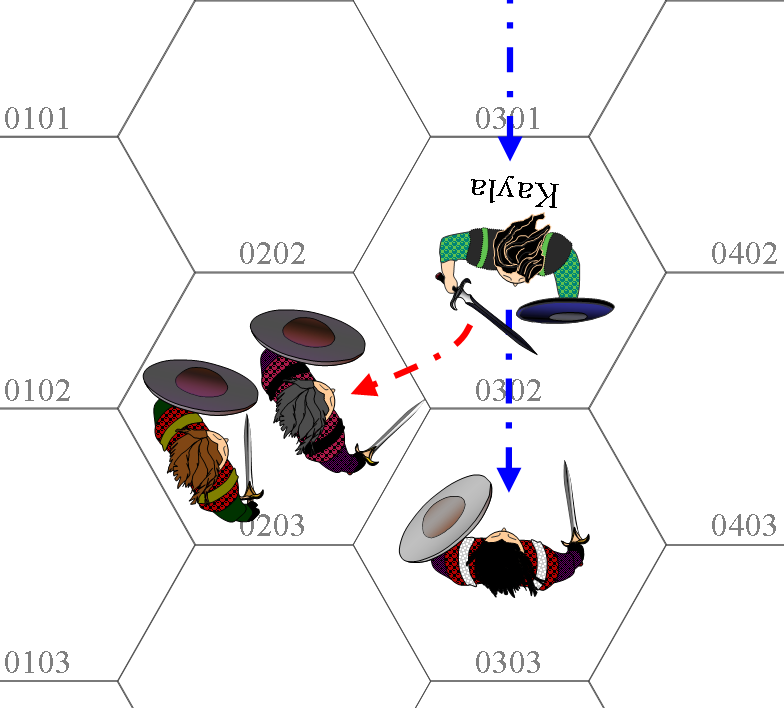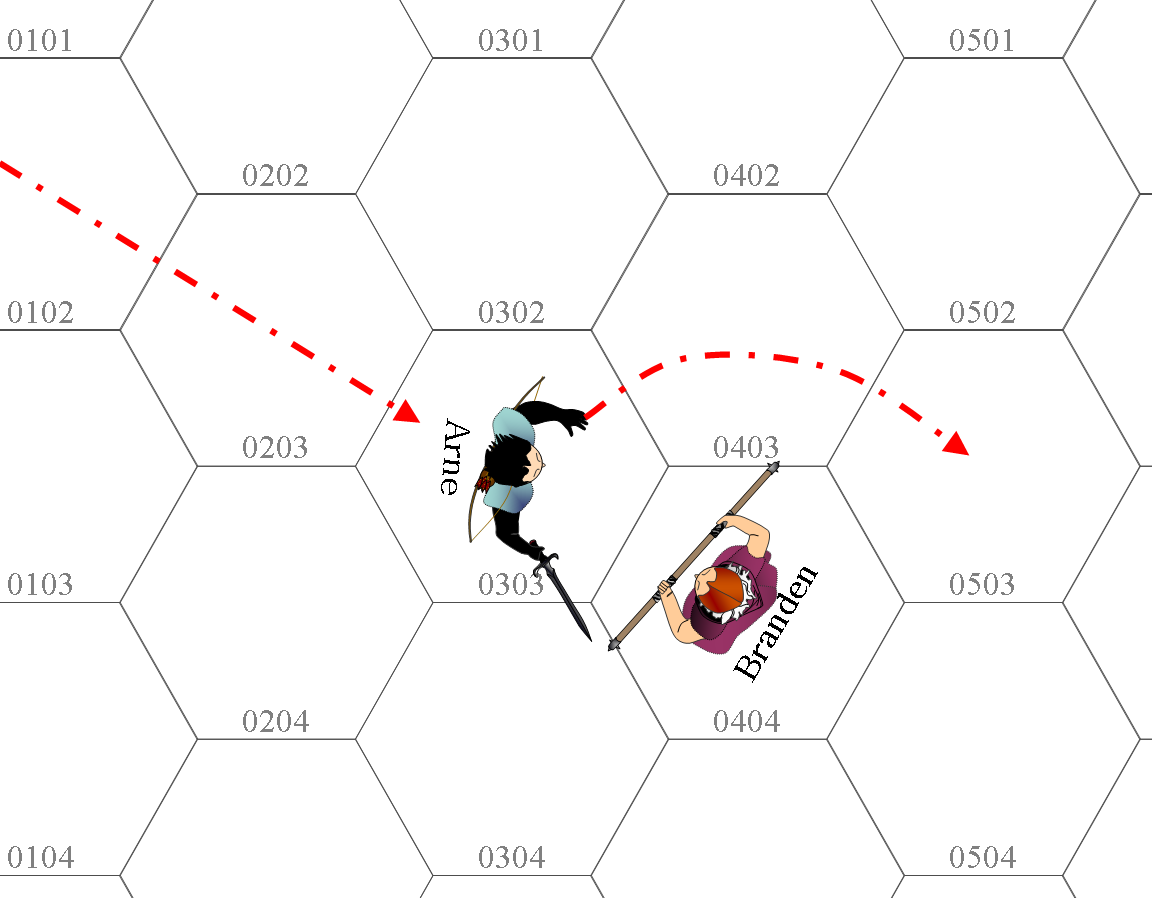Charging
Some rules in the below may conflict with rules under Movement (stride) that are more recent; where a conflict occurs, give precedence to movement (stride) rules.
Charging is a combat attack made at a run, in which the combatant uses that momentum to increase the chance of hitting and the amount of damage done, while also breaking the enemy's will to fight. The act of charging incorporates the effects of overbearing and attacks of opportunity, while momentarily suspending rules related to melee and adjusting the effects of stun lock.
Charges may be made on foot or while mounted; note that only mounts specifically trained for war may be used to charge.
Contents
Movement & Initiative
In order to charge, a combatant must be running or sprinting, which means that for each action point (AP) spent they are moving 4 or more hexes per round. The charger must indicate whether their action will be a direct charge or a passing charge. The distance between the charger and the target is noted and the speed indicated, whereupon it's determined whether or not an attack of opportunity can or will take place. Once this attack is resolved, it must be determined whether or not the defenders will break. This requires a morale check.
Once morale is resolved, an initiative die is rolled to determine who strikes first. This initiative roll is made prior to the movement about to take place, regardless of combatant's location. Before this die is rolled, the charger and the defender must commit to their upcoming movement, and must afterwards follow through, whatever the initiative say.
If the charger is already running towards the enemy on the round when initiative is determined, the charger is awarded a +2 bonus to that initiative roll. After the roll, if the defender wins the initiative, the defender is +2 to hit the charger. The charger always gets +2 to hit when charging, whether or not initiative has been won. These bonuses only apply during the round when the charge takes place. If the charger wins initiative, the defender does not receive a +2 to hit after the charger's attack. That bonus is lost when the defender loses the initiative. Once the charge has been met, normal combat movement and attacks apply.
If combatants are charging one another simultaneously, then no attack of opportunity can be made, nor will either side make a morale check to see if they break. Neither side will receive a bonus to their initiative roll. Both sides will receive a +2 bonus to hit the other, regardless of who wins the initiative.
Direct Charges
A direct charge is a frontal attack against the enemy, intended to force the enemy back from the hex occupied. When a sufficient force of chargers rush a defending position, there is a chance that the defenders will break before the actual combat is met, a matter that must be determined before the charge makes contact.
When resolving this form of charge, the charger effectively receives two independent attacks: the first is a normal roll to hit and the second is an adjusted overbearing attack. Both of these attacks are combined, so that together they count as one attack. Characters able to perform multiple attacks a round would pay a single AP cost of 1 point for both attacks; any other character would pay a cost of 2 points.
Once the charger has won initiative, or if the charger was missed when attacked by the defender, or if the amount of damage done failed to stun the charger, then the charger makes their first attack with a weapon (or a fist), at +2 to hit the defender. When charging, if the enemy is stunned, the enemy falls back 60° left or right, and not straight back, which enables the charger to continue straight ahead if able.
Once this attack is resolved, the second attack determines whether or not the charger successfully overbears the enemy. Here, when calculating the charger's weight, a bonus of +50% is added. For example, if the charger's weight were normally 210 lbs., with respect to charging & overbearing, the charger is counted at 315 lbs. Overbearing is then resolved normally, with overbearing damage, except that as above, the successfully overborne character is pushed left or right and not straight back.
If the charger has sufficient movement, they may complete their movement into the overborne hex and attempt to overbear the next opponent in line. If the charger has another attack, they may again combine attack and overbearing in one movement, or they may only be able to overbear. This second attempt will be 50% of their modified first weight; so in the example above, the charger will be counted as 157 lbs. This process can continue so long as there are enemies in line with the combatant's charge; and the combatant still has movement; and overbearing succeeds, with each progressive attempt to overbear equally 50% of the previous charger's modified weight.
When charging with a mount, the mount's weight is also taken into account; and since the mount will have more potential movement than the rider, this progressive overbearing against foot soldiers can be a very effective attack. However, when riding a mount, the rider cannot combine a direct charging attack with overbearing; when riding, the mount overbears, while the rider performs a passing charge.
Passing Charges
A passing charge is a swinging attack against the enemy as the charger runs past, using speed to bypass the movement penalty when engaging in melee. This suspension of the melee-engage rule is possible because within the narrow window of the charge, the actual melee has yet to be engaged.
Once initiative has been rolled, and the charger has won initiative, or was missed, or failed to be stunned, then the charger rushes the defender with the intent of moving past or around the defender's position. The charger does not move into the defender's hex.
In the example shown, Arne has won initiative. As Arne approaches Branden at a run, spending 1 AP per 4 hexes (stride-4). Arne has 4 AP total. He uses his first to reach 0102, whereupon Branden makes an attack of opportunity. If this misses or fails to stun, Arne uses 1 AP to move up to and around Branden, and 2 AP to attack while he does so, at +2 to hit. The usual melee penalty for moving out of 0303 and 0403 is suspended. At the end of his move, Arne has reached 0503, whereupon Branden may attack if the passing charge failed.
According to the rules above, both Arne and Branden have committed their moves before the initiative die was thrown. If Arne lost initiative, Branden would not gain an attack of opportunity when Arne reached 0102. Instead, Arne would move forward into 0303, whereupon it would become Branden's TURN. Branden would attack at +2 to hit. Assuming this did not stun, Arne would still receive +2 to hit due to charging, but by losing initiative Arne is considered to have lost the momentum of the charge. Arne is engaged in melee now, and normal penalties attached to melee hexes once again apply. Combat between Arne and Branden now takes place normally.
Additionally, if Arne lost the initiative, Branden would be free to avoid the attack entirely by moving out of Arne's path (to 0103 or 0501), where Arne cannot turn efficiently enough to attack without breaking the charge himself on his turn, whereupon he would lose the +2 bonus for charging. For the same reasons that Arne is not subject to melee hex penalties during the charge, Branden is not subject to these penalties either.
If Arne is mounted, the attack happens the same if Arne wins the initiative, except that Arne would be moving at the mount's speed. However, if Arne lost the initiative while mounted, then Arne would have the option of either (a) attacking at +2 and coming to a stop as the mount must be held up; or (b) not attacking at all but continuing the charge as though not attacked. This is because it is assumed that a defender who has won initiative and attacked first, will also duck or dodge so that a mounted attacker will have moved past the defender and will be out of reach with their weapon unless they stop and attack.
Breaking
Breaking is a circumstance whereby horses refuse to gallop into a dense mass of enemies, or a defending formation, due to fear, scatters in fear before a charge. Under applicable circumstances, a morale check against breaking will need to be made prior to determining initiative. For any of these, a morale check must be made AFTER the charger's move has been committed and BEFORE initiative is rolled.
- When a horse attempts a direct charge into a mass of ground troops that is at least 2 hexes deep and 5 hexes wide, or which is at any time 3 hexes deep, then the cavalry must roll to see if they break.
- When the charging ground troops number at least 50 attackers, and are at least equal in number to that of the defenders, and are approximately the same size as the defenders, then the defenders must roll to see if they break.
- When the charging ground troops are larger than the defenders, being at least a foot taller, then the defenders must number at least 40% more in number than the chargers, per foot of height that the chargers are taller. For example, if 5 elves, being 5 ft. in height, charge a group of kobalds, being 3 ft. in height, then there must be at least 9 kobalds defending, or else the kobalds will need to roll to see if they break.
Every individual upon either side will roll their morale check separately when impelled to do so; a single morale check is not made for groups of combatants. When either the chargers or the defenders break, initiative is awarded to the side that breaks.
Player Characters are not subject to breaking.
Chargers Breaking
As movement has already been committed prior to morale checks, the charger will be moved to a distance of 2 hexes from the defenders, where the break takes place. Thereupon, chargers that fail their morale checks will act as though stunned, taking no action until the defenders have had two complete turns.
Defenders Breaking
When defenders break, the result will be that of a failed boldness check. These defenders will rout, and at the first opportunity, other defenders within 2 hexes of the defender that has routed must make a panic check or rout themselves. These rules and their after effects are explained on the morale page.
Additional Notes Regarding Mounts
At present, some playtesting will be necessary before firmly establishing any further special rules regarding the use of mounts while charging.
See Also,
Horse Handling I (sage ability)
Spear (weapon)
Warhorse Training (sage ability)


